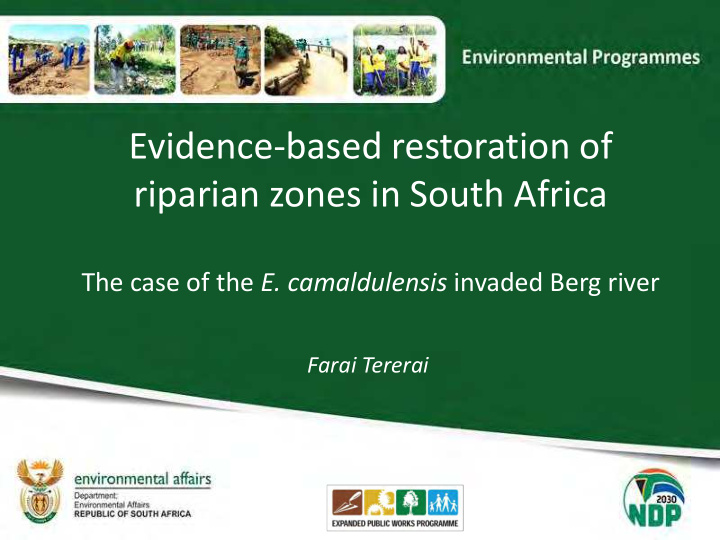



Evidence-based restoration of riparian zones in South Africa The case of the E. camaldulensis invaded Berg river Farai Tererai
• Berg R. = 294km; <8000km2 catchment – 65% agriculture; perennial flow • Whole River invaded – with mainly eucs (c.50yrs), interspaced with Populus spp. , A. mearnsii • Invasion intensity - >75% • Disturbance agents – hydrology, IAP clearing, seldom fire
Berg River catchment
Restoration questions • What are the impacts of eucalyptus invasions in riparian zones? – Geomorphology – Above-ground vegetation – Soil-seedbank – Soil physico-chemical properties (allelopathy, water repellency, etc • What are the best clearing methods? – At what stage of invasion do you intervene • What are the best restoration methods? – Active vs passive • Monitoring and evaluation framework
What are the impacts of E. camaldulensis invasions Geomorphology & Soil legacy effects e.g. Transformers – Native veg. to monocultures, erosion & bank collapse, allelopathy, water native seedbank depletion repellency Hydrology related effects Key ecosystem services being affected
Geomorphology e.g. erosion & bank collapse Channel blockages
• Native vegetation diversity, composition and structure changed
• To what extent do native soil-stored seedbanks provide reliable sources for autogenic recovery
Restoration challenges of previously invaded riparian zones
Implications for management and restoration • Restoration to pre-invasion condition is often untenable – rather target restoration of function • Target to reduce the influence of invasions to levels where natural disturbance drive change • Secondary invasions are a real threat to cleared areas • You cannot be absolute about causation – so apply these results with caution
Farai Tererai, PhD (Stell) Deputy Director: Planning, Monitoring and Evaluation Working for Wetlands Natural Resources Management Programme Department of Environmental Affairs, Environment House, 473 Steve Biko Road, Arcadia 0083 Pretoria Tel: +27 (0)12 399 8970 Cell:+27(0)73 994 3940/(0)81 738 3057 Email: ftererai@environment.gov.za
Recommend
More recommend